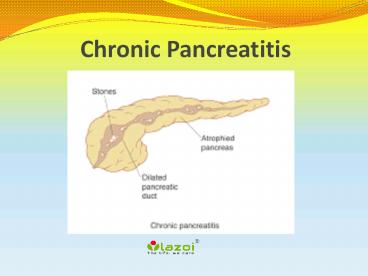Chronic Pancreatitis: Causes, Symptoms, Diagnosis and Treatment of Chronic Pancreatitis - PowerPoint PPT Presentation
Title:
Chronic Pancreatitis: Causes, Symptoms, Diagnosis and Treatment of Chronic Pancreatitis
Description:
Inflammation of pancreas due to chronic pancreatitis reduces the production of the digestive juices and also the amount of hormones secreted by the pancreas. – PowerPoint PPT presentation
Number of Views:296
Title: Chronic Pancreatitis: Causes, Symptoms, Diagnosis and Treatment of Chronic Pancreatitis
1
Chronic Pancreatitis
2
Chronic Pancreatitis
- Pancreas is a large gland present near the
stomach. There are two important functions
performed by pancreas in the digestive system.
The first is to secrete important hormones like
insulin and glucagon while the second is to
produce digestive juices that help to break down
fats, proteins, and carbohydrates in the small
intestine. Inflammation of pancreas due to
chronic pancreatitis reduces the production of
the digestive juices and also the amount of
hormones secreted by the pancreas. There are two
types - acute pancreatitis and chronic
pancreatitis. Here we shall look into the causes,
symptoms, and treatment of the latter.
3
Causes of chronic pancreatitis
- Alcohol consumption is the primary cause,
contributing 70 of the total cases. A prolonged
period (i.e. 10 years or more) of alcoholism
increases the risk of this disease. There are
many other causes, and some of them are listed
below - Cystic fibrosis
- Genetic disorder (namely, mutation of the 'gene
7', which can be inherited from parents and the
syndrome so acquired, is hereditary pancreatitis) - Cancer / Gallstones (resulting in the narrowing
of the pancreatic duct) - Anatomical problem (like a person born with
structural problems of the pancreas) - Hyperparathyroidism or over-secretion of hormones
by the parathyroid gland(leading to elevation
in calcium levels) - Injury or trauma to the pancreatic area causing
inflammation
4
Symptoms
- Abdominal pain is the chief symptom. The
patient suffers from severe pain in the upper
part of abdomen. This pain may be continuous, may
increase after eating or drinking anything, and
may last from a few hours to 1-4 days. The list
of other symptoms observed is given below - Vomiting
- Weakness
- Jaundice
- Diabetes
- Fatty stools
- Nausea
- Digestion Problem
5
Diagnosis of chronic pancreatitis
- It is seen more commonly in men between ages
30-40. On observation of any of the symptoms, the
physician will suggest a gastroenterologist (speci
alist of digestive system disorders) for its
diagnosis. The blood and faeces samples are
taken, and sent to laboratory for tests. These
tests, however, are not enough to confirm the
diagnosis, and more tests are required. Most of
these tests are imaging tests that give an image
of the pancreas, and help to determine if there
is any inflammation. These tests that confirm the
diagnosis are given below - Magnetic Resonance Imaging (MRI) It takes
multiple X-rays and provides a detailed cross
sectional image of the abdominal area around the
pancreas. - Ultrasonography An image of the pancreas is
created on the monitor by passing sound waves
through the patient's body. This image is called
sonogram.
6
Diagnosis of chronic pancreatitis
Continue
- ERCP (Endoscopic retrograde cholangiopancreatograp
hy) X-rays of the pancreatic ducts are taken by
inserting an endoscope (flexible tube with camera
at the inserted end) through patients body. - EUS (Endoscopic Ultrasound) It is a test that
combines the techniques used in ultrasound and
ERCP. The sound waves are directed towards
pancreas from the endoscope. - Biopsy Sample of the pancreatic tissue is taken
and sent to laboratory for further testing.
7
Treatments
- The treatment focuses on reducing the abdominal
pain and solving the digestive problems. - A diet plan that includes low fat and high
calories and proteins is usually suggested. - People, who drink alcohol excessively, should
completely stop drinking to avoid dire
consequences. - To reduce the pain of the abdomen, medications
like Tramadol are recommended. There may be some
side effects of this, so, any medication should
be taken only after consultation with the
gastroenterologist. - Pancreatic supplements are also given to increase
the level of enzymes, or the digestive juices
that are not secreted by pancreas. Even these
medications may have side effects, and proper
prescription of a physician is recommended.
8
Treatments
Continue
- Anatomical problem of the pancreatic duct that
leads to sever abdominal pain may need a surgery. - Treatment for this disorder due to gallstones may
involve removal of the gallbladder. - Patients, who develop diabetes due to this
syndrome, need to maintain the insulinlevel with
medications or by injecting insulin.Chronic
pancreatitis is not a curable disease, but the
symptoms can be reduced. The disease may reduce
the life expectancy of the patient. So, timely
treatment is essential, and one should stop
drinking alcohol if it was the major cause. Not
only this disease, but many other diseases can be
prevented by eating healthy food and by avoiding
alcohol consumption.
9
CONNECT WITH US
- Logon to
- www.lazoi.com
- Like us on Facebook
- https//www.facebook.com/LazoiTheLife
- Follow us on Twitter
- https//www.twitter.com/lazoithelife
- Follow us on Pinterest
- https//www.in.pinterest.com/lazoithelife































